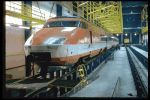You are connected on the site www.liennard.com
![]()
Our Email adress is : alain@liennard.com
![]()
THE IDEA of a high speed train in France was born about 20 years before the first TGVs entered service. At that time, about 1960, a radical new concept was thought up; combining very high speeds and steep grades would allow a railway to follow the contours of existing terrain, like a gentle roller-coaster. Instead of 1 or 2 percent grades which would be considered steep in normal applications, up to 4 percent would be feasible, thus allowing more flexible (and cheaper) routing of new lines. Over the next several years, this very general idea gave rise to a variety of high speed transportation concepts, which tended to move away from conventional wheel on rail vehicles. Indeed, the French government at the time favored more "modern" air-cushioned or maglev trains, such as Bertin's AeroTrain. Steel wheel on rail was (wrongly) considered a dead-end technology, the ugly duckling of the quest for higher speeds.
Simultaneously, SNCF (the French national railways) was trying to raise the speeds of conventional trains into the range 180 to 200 km/h (110 to 125 mph) for non-electrified sections, by using gas turbines for propulsion. Energy was reasonably cheap in those years, and gas turbines (originally designed for helicopters) were a compact and efficient way to fulfill requirements for more power. Following on the TGS prototype in 1967, SNCF introduced gas turbine propulsion with the ETG (Elément à Turbine à Gaz, or Gas Turbine Unit) turbotrains in Paris - Cherbourg service, in March 1970.
The desire for higher speeds and the successful development of the turbotrain program are two ideas that came together in the late 1960s, further spurred on by the 1964 start of the Japanese Shinkansen high speed train. They were embodied in a joint program between SNCF and industry to explore the possibility of a high speed gas turbine unit. The project, initiated in 1967, was entitled "Rail Possibilities on New Infrastructures" and was code-named C03.
The experimental X4300 TGS railcar, predecessor of the ETG, had been tested at speeds up to 252 km/h (157 mph) in October of 1971, and gave promising results. Since the very high speed lines envisioned by SNCF called for speeds of 250 km/h to 300 km/h (186 mph), SNCF had Alsthom-Atlantique build a special high speed turbotrain prototype to test out some concepts in high speed rail. Thus was born the turbotrain TGV (Très Grande Vitesse, or Very High Speed) 001.

The TGV 001 consisted of two power cars with three trailers in between, the whole trainset permanently coupled together. All axles were powered by electric motors, with the advantage of low axle loads and a high power to weight ratio. Electric traction also made possible dynamic braking, especially effective at high speeds. Each power car had a pair of turbines (the TURMO IIIG and then the TURMO X, used in Sud Aviation's Super Frelon helicopter) which ran at constant speed. They were connected to a reductor stage, whose output shaft drove an alternator. Besides the turbine drive, the power cars had control gear for the traction motors, dynamic brake grids, signalling and braking equipment, etc.
The TGV001 was articulated, with adjacent vehicles riding on a common truck. This afforded a greater stability (by coupling the dynamics of carbodies) and made space for a pneumatic secondary suspension placed level with the center of gravity, thus reducing roll in curves.
SOME TECHNICAL SPECIFICATIONS OF THE TGV 001